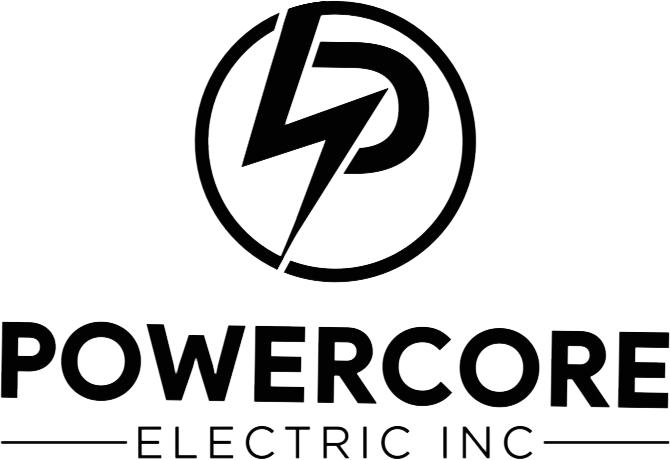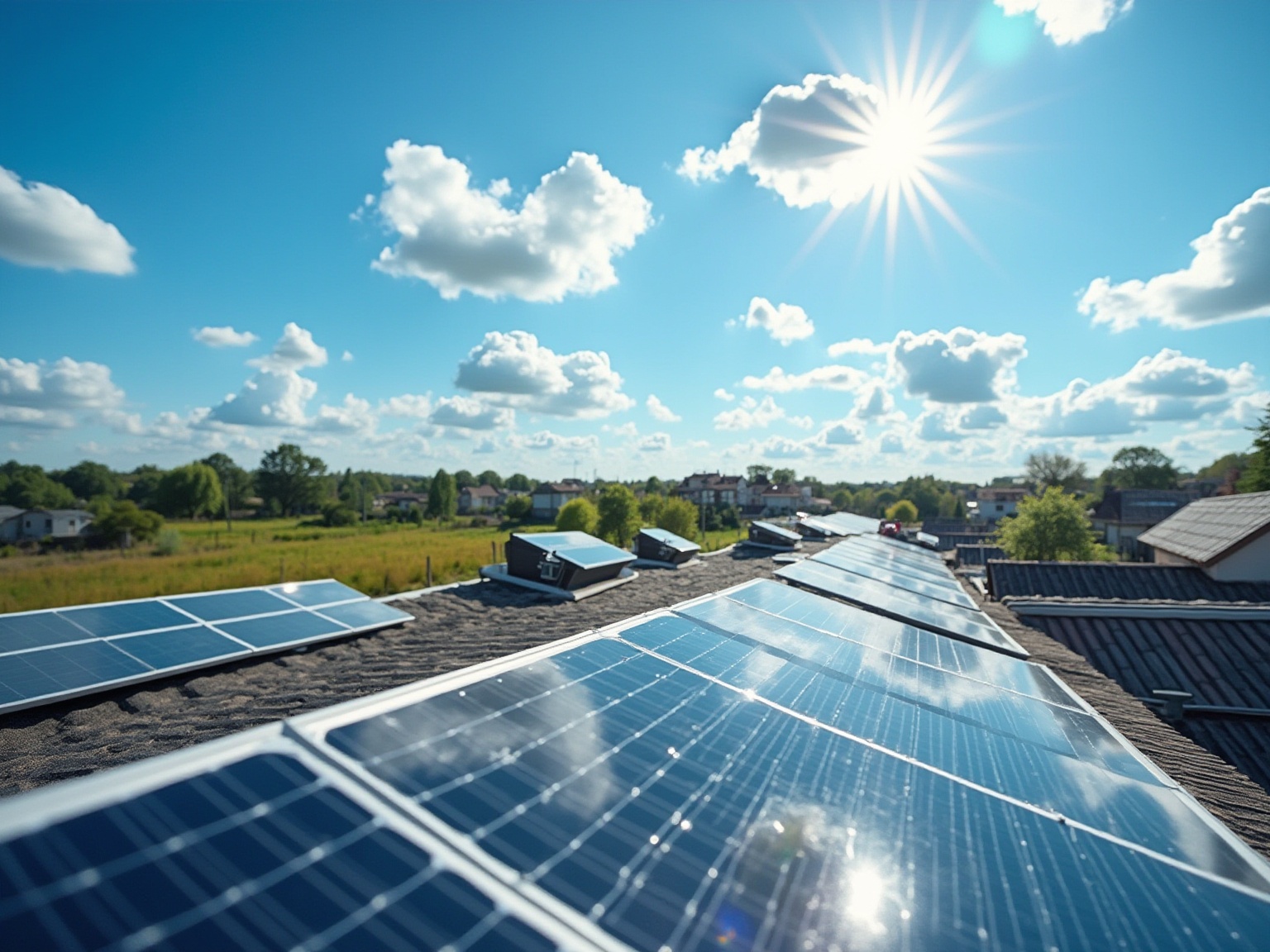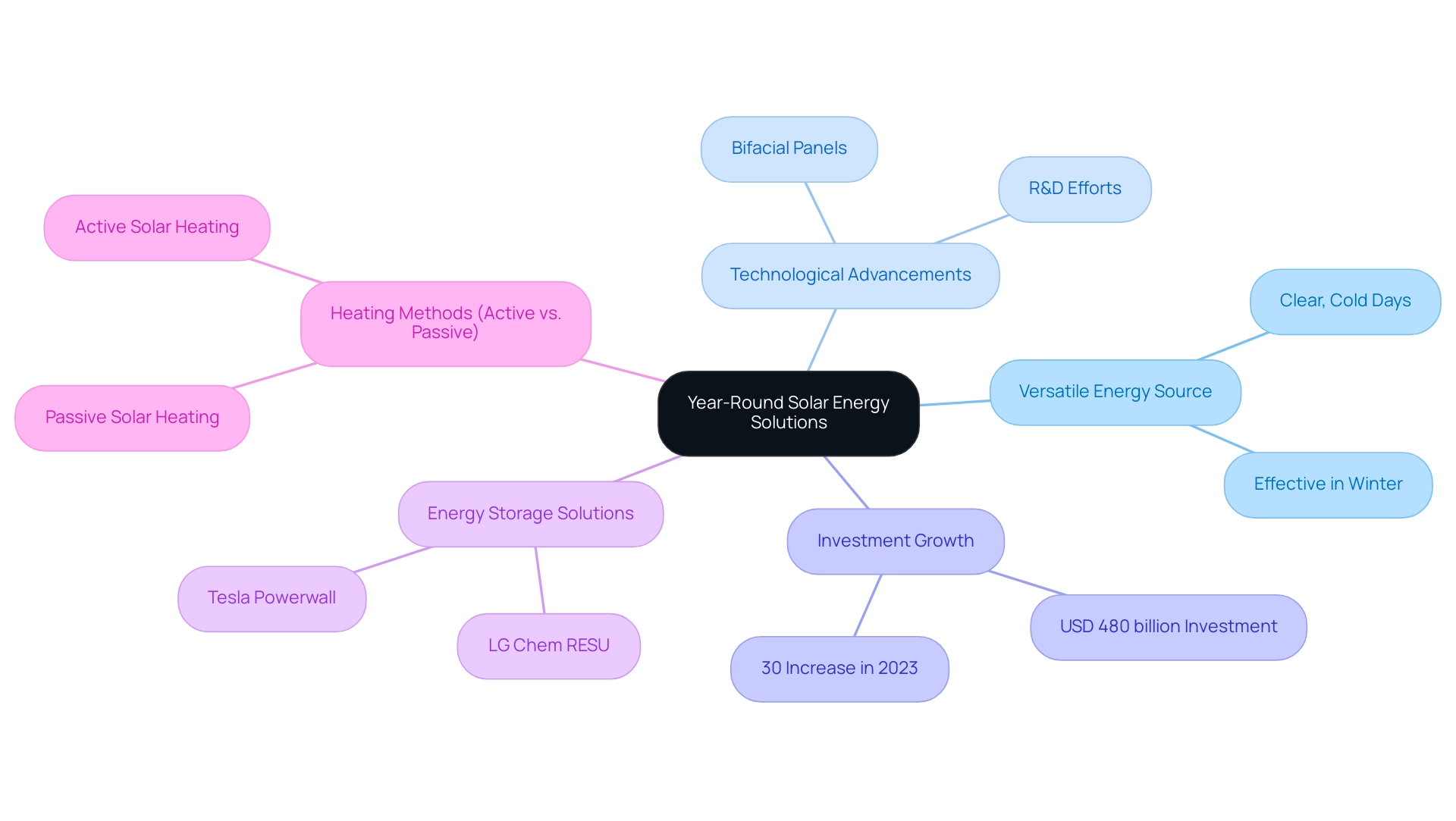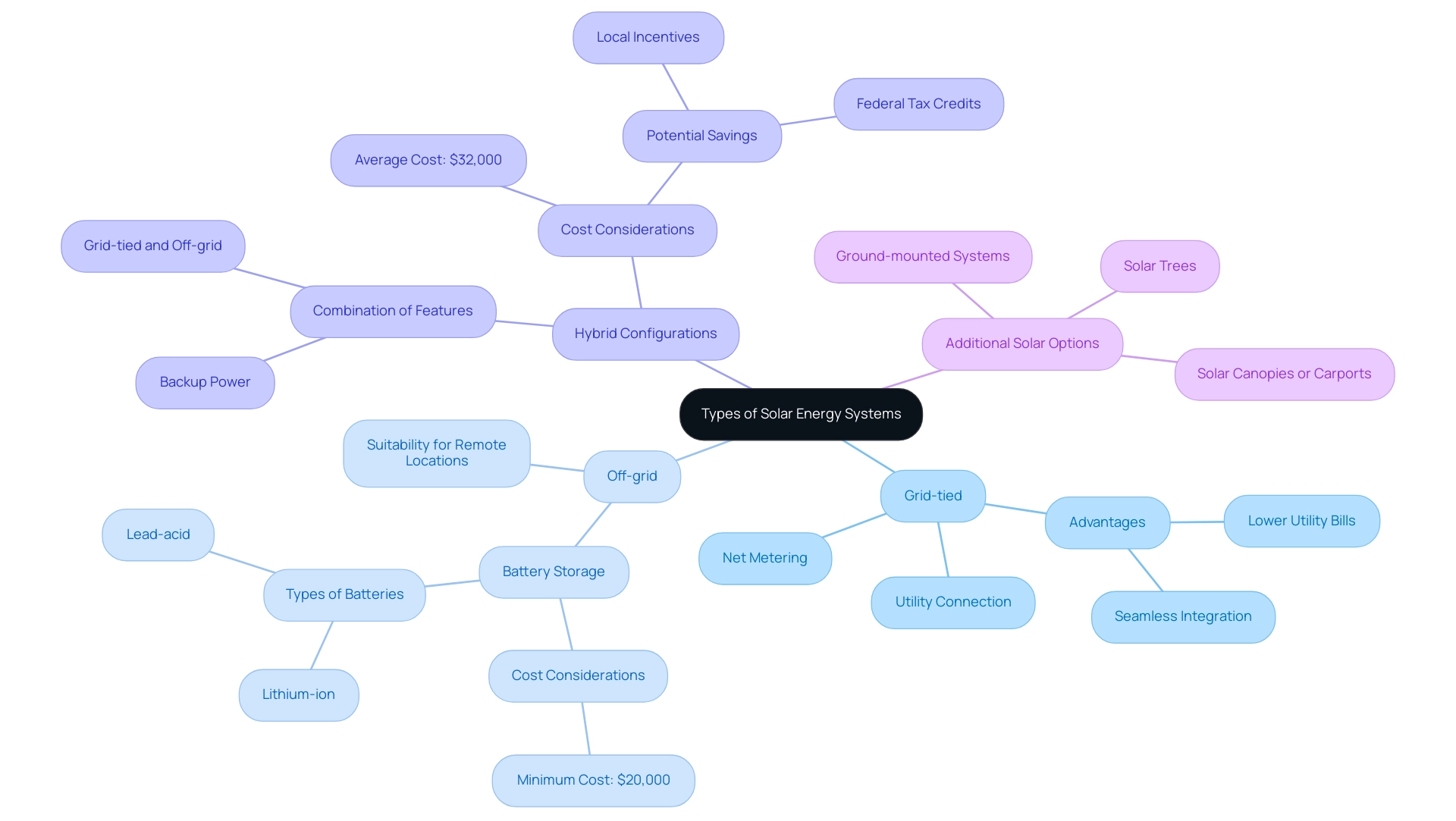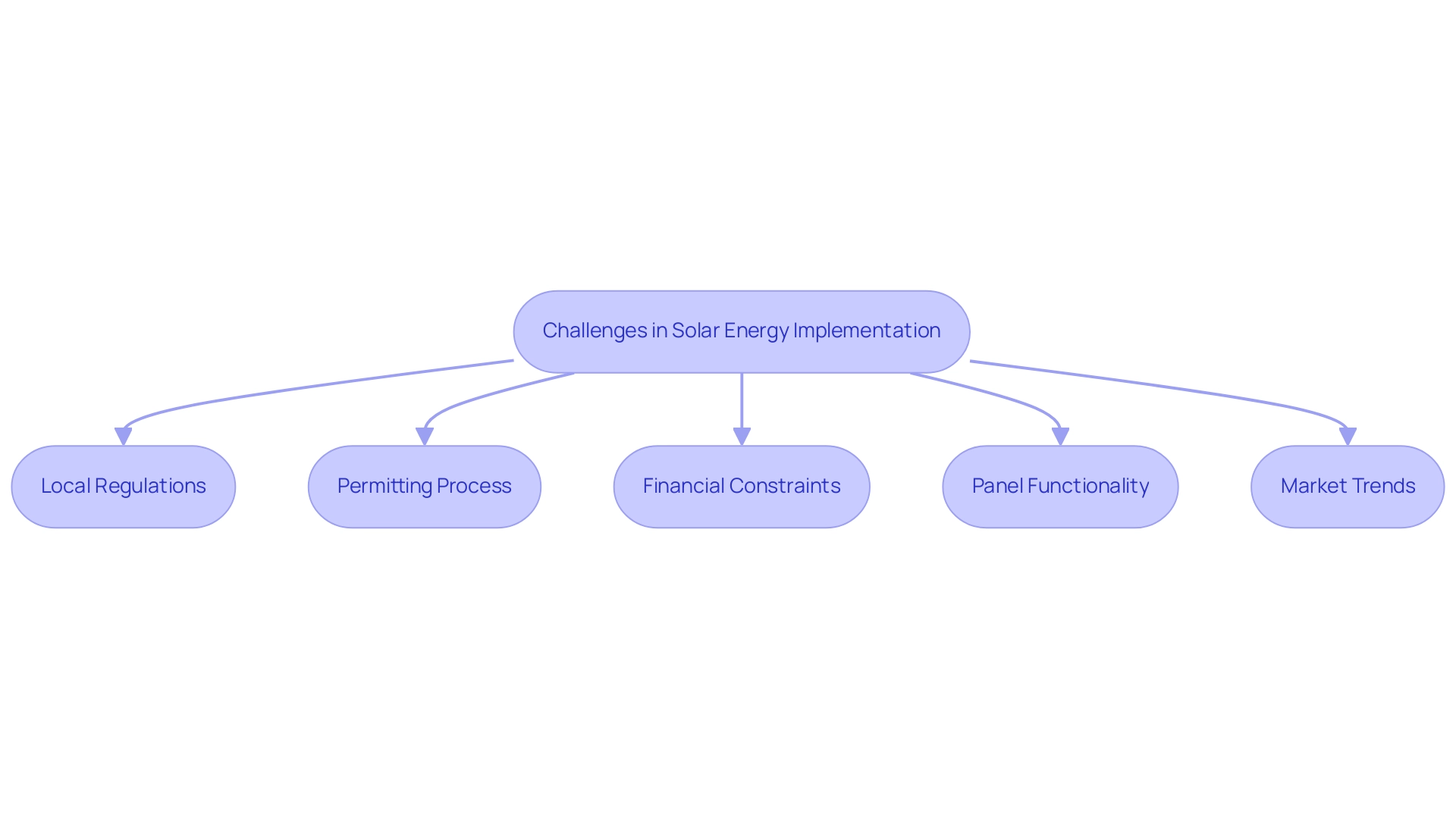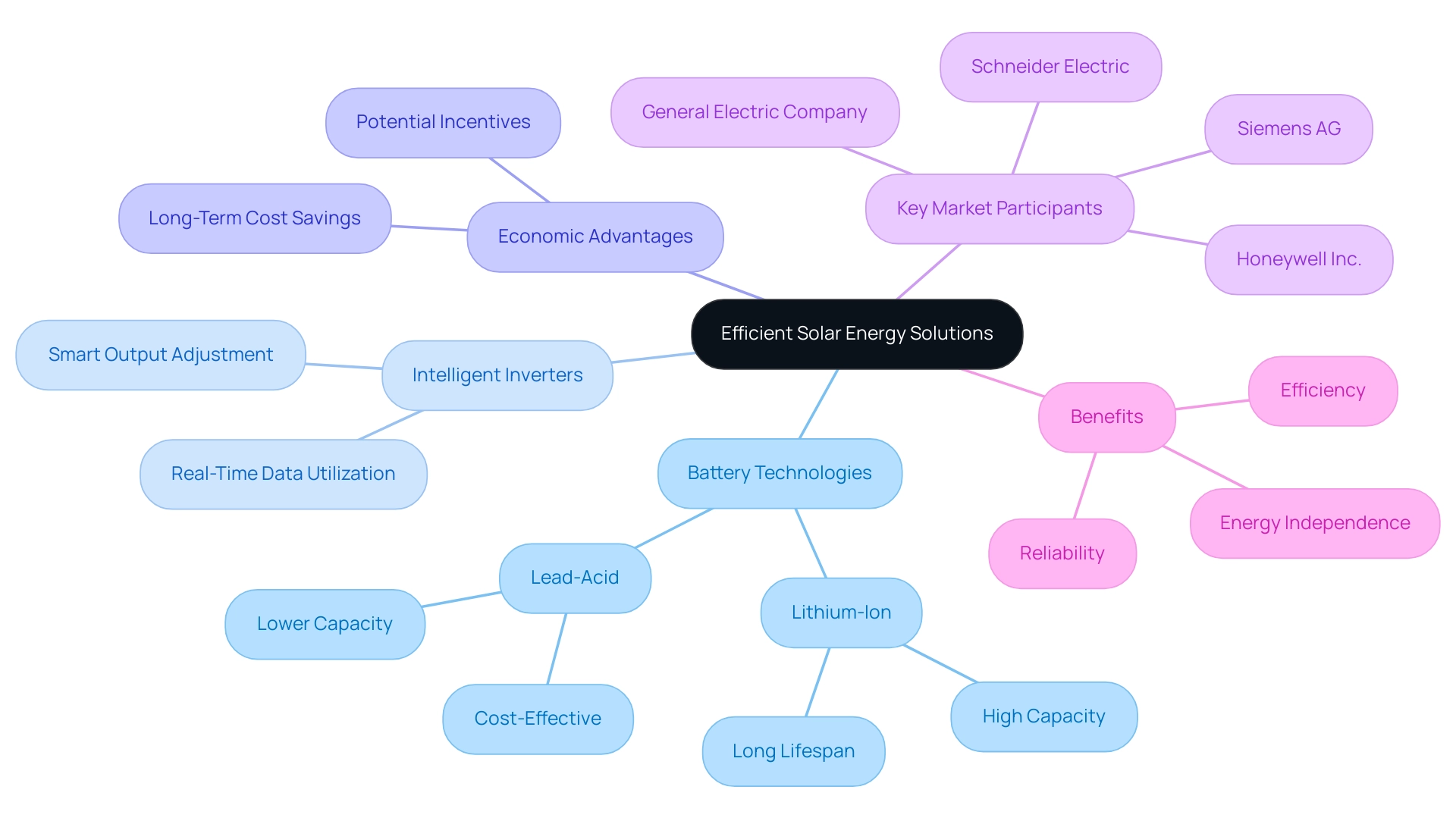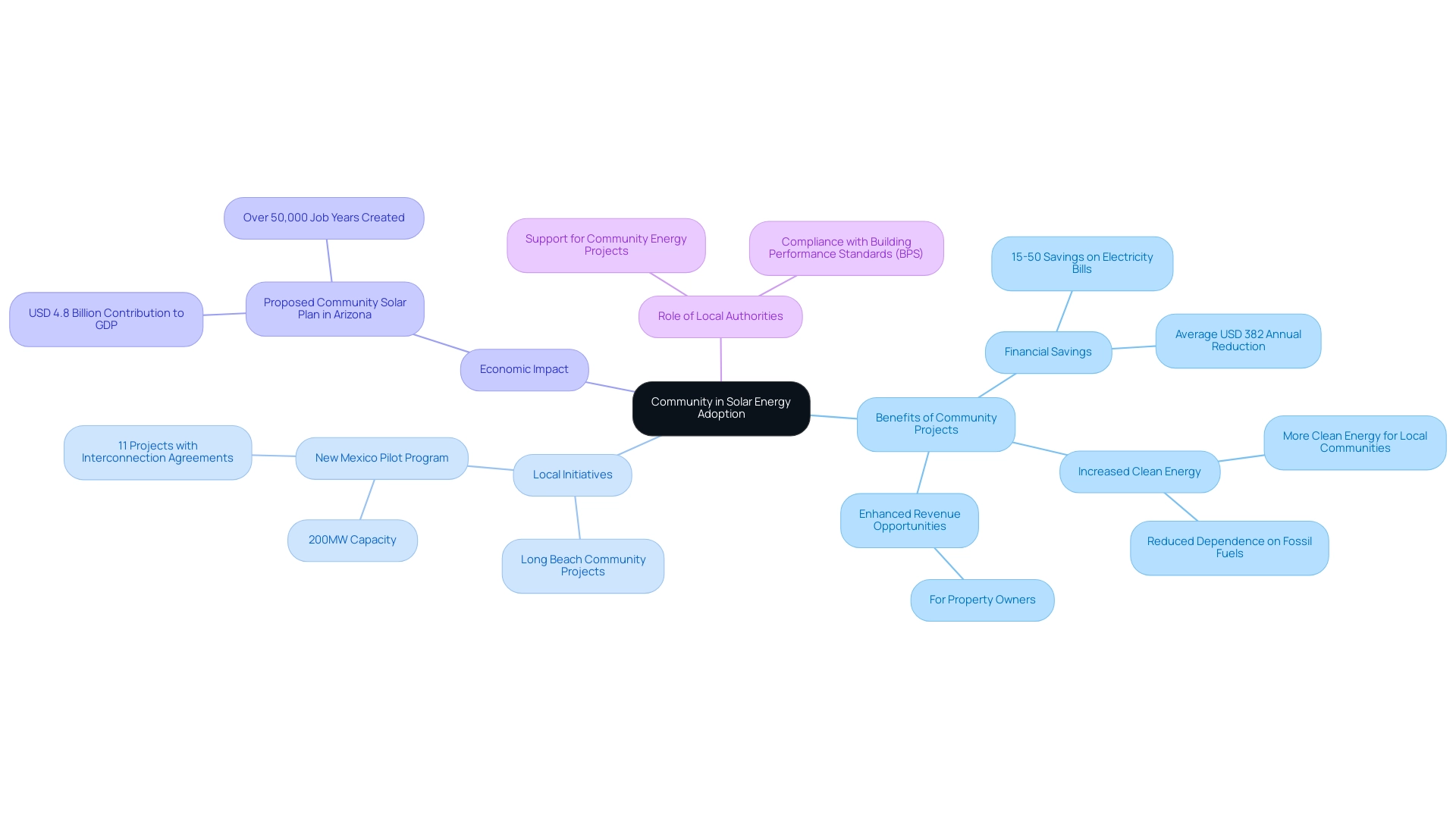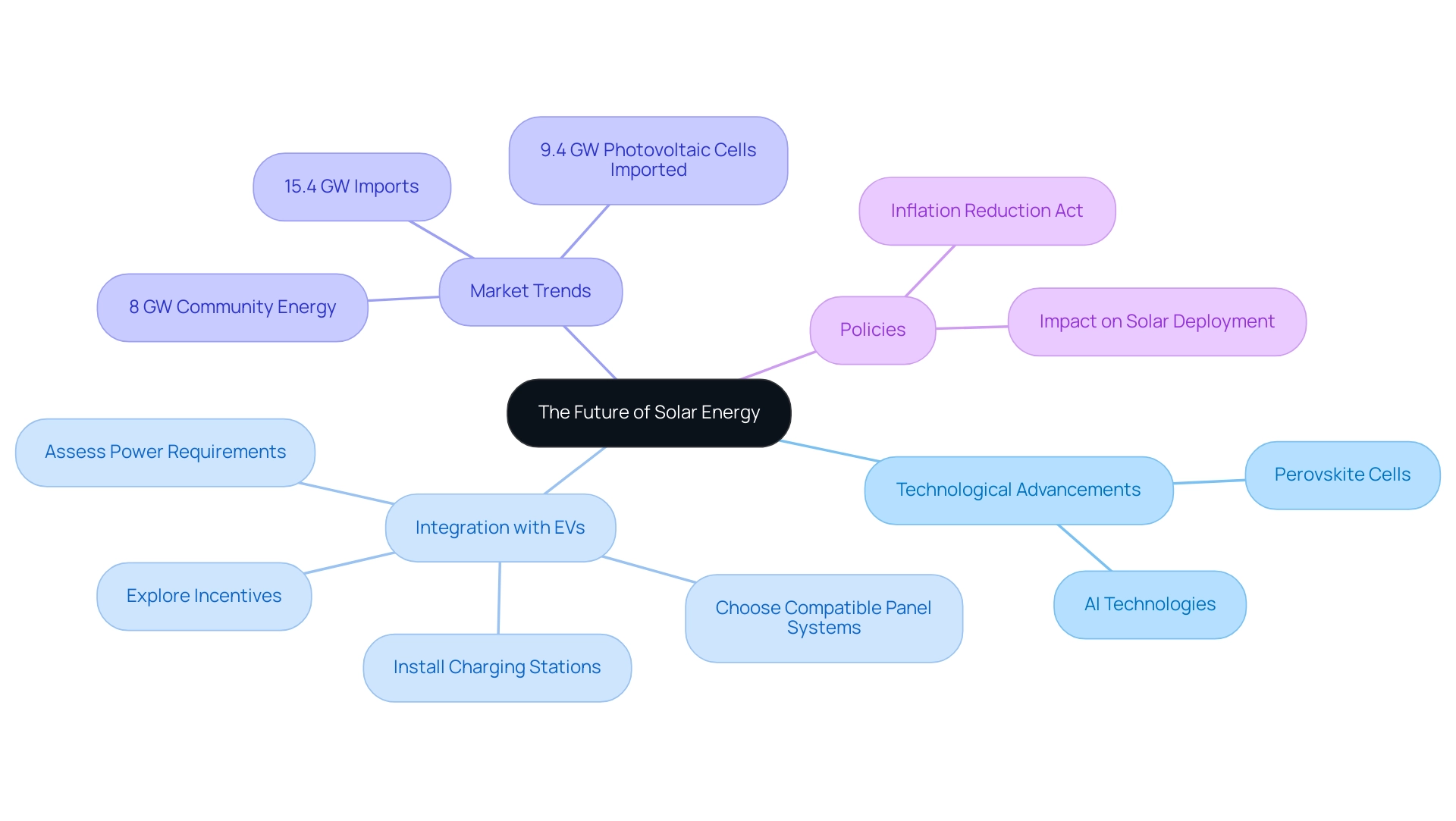Overview
We understand that many homeowners are concerned about rising energy bills, especially during the winter months. It’s a common belief that solar panels are ineffective in colder weather, but that’s simply not true. All-season solar energy solutions are effective year-round, generating significant electricity even when temperatures drop. This is made possible by advancements in solar technology, such as bifacial panels and increased investments in photovoltaic systems. These innovations enhance energy production, making solar a viable and sustainable option for homeowners throughout the year. Together, we can explore how these solutions can lead to energy independence and help you take control of your energy costs. Let’s work towards a brighter, more sustainable future by considering how solar energy can benefit you and your family.
Introduction
In a world increasingly driven by sustainability, we understand that many homeowners are concerned about rising energy bills. Solar energy emerges as a beacon of hope, promising not only environmental benefits but also financial savings. It’s common to feel uncertain about the effectiveness of solar panels, especially in winter. However, advancements in technology have proven otherwise, allowing you to harness solar power year-round. The surge in investments and innovations, such as bifacial solar panels and efficient battery storage systems, underscores a growing recognition of solar energy’s potential.
As you navigate the complexities of different solar systems, from grid-tied to community solar projects, understanding the nuances of energy production and local regulations becomes essential. Together, we can explore the multifaceted landscape of solar energy solutions, uncovering their benefits, challenges, and the exciting future that awaits as technology continues to evolve. Let’s work towards a more sustainable and independent energy future, where you can enjoy peace of mind knowing you’re making a positive impact.
The Importance of Year-Round Solar Energy Solutions
Are you feeling the pinch of rising energy bills? You’re not alone. Many homeowners share your concerns, especially during the colder months when the thought of solar energy often seems less appealing. However, it’s essential to recognize that solar energy is a versatile resource that extends beyond just summer usage. It serves as a reliable all-season energy source throughout the year. While it’s a common misconception that energy panels become ineffective in winter, the truth is that they can still produce significant electricity, particularly on clear, cold days when the air is less dense, allowing for improved energy absorption.
Recent advancements in technology, such as bifacial panels that capture sunlight from both sides, have further enhanced energy production even in less-than-ideal conditions. In fact, investments in photovoltaic capacity additions soared by approximately 30% in 2023, surpassing USD 480 billion. This remarkable growth marks a record year for investment, showcasing a growing recognition of solar energy’s potential throughout the year. This increase in investment reflects ongoing R&D efforts aimed at achieving efficiency gains and cost reductions, which can ultimately benefit you.
Furthermore, many global and bilateral collaboration initiatives are advancing technological development and policy support for all-season solar systems. This means that environmentally aware property owners like you can maximize your investments in renewable energy at any time of the year. Together, we can pave the way for a more sustainable future.
To enhance your energy independence and reduce those utility expenses, consider integrating high-quality energy storage batteries, such as the Tesla Powerwall or LG Chem RESU. These solutions provide efficient energy storage, ensuring you have access to power when you need it most. Additionally, utilizing eco-friendly cleaning options, like biodegradable soap and water or specialized panel cleaning solutions, can help maintain the optimal performance of your solar panels.
By understanding the distinctions between active and passive solar heating methods, you can better leverage both approaches to suit your needs. Active setups, which use pumps and controls to circulate heat transfer fluids, are ideal for homes requiring consistent heating. Meanwhile, passive arrangements, relying on building design to optimize heat absorption, are simpler and less costly to install. This informed decision-making process ensures that the selected solution provides optimal performance while contributing to a sustainable and energy-efficient home.
It’s common to feel overwhelmed by the options available, but remember, you are not alone in this journey. By exploring these solutions, you can take meaningful steps toward energy independence and a brighter, more sustainable future.
Exploring Different Types of Solar Energy Systems
Are you feeling overwhelmed by rising energy bills? You’re not alone. Many homeowners share your concern, and that’s where solar power solutions come into play. These solutions can be classified into three main types:
- Grid-tied
- Off-grid
- Hybrid configurations
Grid-connected setups are the most common among property owners, enabling a seamless link to the local utility grid. They utilize net metering, allowing you to receive credits for any surplus power you generate, effectively lowering your utility bills.
On the other hand, off-grid systems stand apart as they operate independently of the grid, making them particularly suited for remote locations. However, we understand that the implementation of off-grid solutions often necessitates substantial investments in battery storage, with costs starting at around $20,000. This can be a significant consideration for many potential users. Choosing the appropriate solar batteries, like lithium-ion or lead-acid types, is vital for effective power storage.
When evaluating these options, consider specifications like capacity, discharge rates, and lifespan, along with economic advantages such as return on investment and possible savings on utility bills. Hybrid setups provide a versatile solution by merging features of both grid-connected and standalone configurations, giving you enhanced flexibility and power autonomy, costing at least $32,000 on average. Furthermore, potential savings from federal tax credits and local incentives can further mitigate these expenses.
As Rohit Kalyanpur, CEO of Optivolt, wisely notes, “Each off-grid photovoltaic setup installed at a site must be tailored to fulfill the distinct power requirements of the individuals at that site.” You can also explore various photovoltaic options, including ground-mounted systems, solar trees, and canopies or carports, which broaden your selections in renewable sources. Together, we can ensure that choosing the suitable power setup necessitates a thorough evaluation of several factors, such as location, particular power needs, battery specifications, and overall budget.
This strategic approach guarantees that you can maximize your investment in renewable technology while addressing your specific power requirements. Let’s work towards a more sustainable future together, ensuring that your energy needs are met with compassion and understanding.
Navigating Challenges in Solar Energy Implementation
Installing all-season solar photovoltaic systems can indeed present challenges, especially for Long Beach tenants who are eager to explore environmentally friendly options. We understand that navigating local regulations and obtaining the necessary permits can feel overwhelming. As outlined in the ‘Essential Guide for Long Beach Renters,’ it’s essential to be aware of specific requirements and potential incentives that may be available for renewable installations. Homeowners are encouraged to conduct thorough research on local laws to feel empowered in their decisions.
It’s reassuring to note that 85% of installers using NREL’s SolarAPP+ permitting software report that it significantly simplifies the permitting process. This highlights the importance of utilizing available tools to ease compliance. While financial constraints can be daunting, various financing options and tax credits are designed to lighten the initial investment burden. As Ben Zientara, a Solar Policy Analyst, points out, understanding local regulations is crucial for successful installations.
When considering panel functionality, it’s vital to grasp the significance of residential panel sizes and the benefits of the 200% Rule. This rule allows homeowners to install all-season solar systems capable of producing up to 200% of their annual power consumption, leading to substantial savings on utility bills. Additionally, the cost of photovoltaic technology has decreased by 37% over the past decade, contributing to a reduction of carbon emissions by 227 million metric tons, making this energy source more accessible than ever.
As of October 28, 2024, over 9.4 GW of photovoltaic cells have been imported, accounting for 75% of the tariff-rate quota. This indicates the ongoing supply chain dynamics that may affect installation timelines. Engaging with reputable energy providers can streamline the installation process while ensuring all regulatory requirements are met. Moreover, a recent case study reveals that despite the challenges faced in 2023, 54% of renewable energy installers remain optimistic about increased sales and growth in 2024, suggesting a promising trend for individuals investing in renewable solutions.
This case study illustrates how homeowners have successfully navigated these challenges and reaped the benefits of residential energy systems, further underscoring the importance of understanding the 200% Rule. Together, we can work towards a sustainable future, ensuring that your journey into renewable energy is as smooth and rewarding as possible.
Leveraging Technology for Efficient Solar Energy Solutions
We understand that managing energy bills can be a significant concern for homeowners. Emerging technologies are transforming the efficiency of photovoltaic solutions, particularly with advancements in battery storage technology and intelligent inverters. Smart inverters optimize usage by adjusting output based on real-time data regarding production and consumption. This capability not only enhances efficiency but also improves the overall performance of solar systems, offering you a more reliable energy source.
As Rod Walton, Managing Editor, emphasizes,
We want the transition to make their lives better in the future.
Coupled with the projected annual rise of household power usage by 0.3% through 2040, the necessity for efficient solutions becomes even more critical. In this landscape, understanding panel functionality and choosing the appropriate batteries—such as lithium-ion and lead-acid types with varying capacities and power ratings—is essential for effective residential power management and sustainability.
Homeowners can store surplus power generated during sunny periods for use during cloudy days or nighttime, ensuring a consistent supply. Significant instances of power management systems, like Honeywell’s Forge Analytics Platform, enable homeowners to monitor and strategically utilize their renewable resources. The economic advantages of photovoltaic batteries, including long-term cost savings and potential incentives, further enhance their appeal.
Key participants in the EMS market, including Honeywell Inc., Schneider Electric, Siemens AG, and General Electric Company, are driving innovations that enhance autonomy. By incorporating these technologies, eco-conscious homeowners can significantly enhance the performance and dependability of their photovoltaic setups, maximizing their investment in renewable resources while considering types, specifications, and economic advantages of batteries.
Together, we can work towards a more sustainable future. Let’s explore how these advancements can not only reduce your energy costs but also empower you with energy independence.
The Role of Community in Solar Energy Adoption
Community projects serve as a transformative method for Long Beach renters, addressing concerns about rising energy bills and enabling collective renewable power adoption. Imagine numerous households benefiting from an all-season solar system, especially for those facing barriers like restrictive rental agreements or limited access to individual installation options. This model broadens access to renewable resources, fostering a sense of community and shared responsibility. Recent trends illustrate that households enrolled in low-income energy programs in Colorado enjoy substantial savings on their electricity bills, with reductions averaging between 15-50%, translating to approximately USD 382 annually. These statistics highlight the concrete financial advantages of community renewable initiatives.
We understand that participation within communities is crucial to the success of these projects. It promotes awareness and education about the benefits of harnessing sunlight. According to Dennis Schoenmaker, Ph.D., Executive Director & Principal Economist at CBRE Econometric Advisors, the benefits include:
- Increased clean energy for local communities
- Enhanced revenue opportunities for property owners
- Reduced dependence on fossil fuels
- Compliance with government Building Performance Standards (BPS) or other climate mitigation measures
Local authorities and organizations play a vital role in supplying the necessary resources and support for all-season solar community energy projects.
For instance, in New Mexico, legislation has enabled a 200MW pilot program since April 2021; however, as of November 2024, only 11 projects have entered interconnection agreements. This highlights the current challenges in scaling community energy initiatives, but it’s common to feel hopeful as the decreasing costs of all-season solar installations further enhance the economic viability of these projects. They are becoming more accessible to low- and moderate-income households. In Long Beach, local initiatives are emerging to facilitate community energy access, with potential savings that could mirror those seen in other regions.
A proposed community energy plan in Arizona has been assessed for its potential economic effect, predicting around $4.8 billion in state gross domestic product contributions and the generation of over 50,000 job years of employment over 35 years. Such real-world examples demonstrate how community renewable projects not only improve efficiency but also boost local economies, resulting in a more sustainable and resilient community. Together, we can work towards a brighter, greener future.
The Future of Solar Energy: Innovations and Trends
The prospects of sunlight power are truly encouraging, especially for homeowners who may be feeling the strain of rising energy bills. Ongoing advancements are improving both efficiency and accessibility, making solar energy a more viable option for many. Key advancements, such as the development of perovskite photovoltaic cells, deliver superior efficiency at reduced costs. This is particularly beneficial for residents in Santa Cruz who face challenges with shaded properties. Furthermore, the incorporation of AI technologies in renewable solutions is transforming how residents optimize their power production, particularly in regions like Silicon Valley.
We understand that integrating electric vehicles (EVs) with renewable sources can seem daunting. However, this collaboration is poised to enhance both autonomy and sustainability. To effectively integrate EVs into your energy solutions, consider the following steps:
- Assess your power requirements
- Choose compatible panel systems
- Install home EV charging stations
- Explore available incentives for sustainable driving solutions
Recent trends show that U.S. module imports reached nearly 15.4 GW in Q3 2024, indicating a robust demand for energy solutions.
As we look ahead, cumulative community energy volumes are anticipated to exceed 8 GW in 2024, highlighting the exciting growth trajectory of renewable power. Additionally, over 9.4 GW of photovoltaic cells have been imported as of October 28, 2024, reflecting the dynamic market landscape. With supportive policies like the Inflation Reduction Act boosting projections for renewable energy deployment by 46%, eco-conscious homeowners can anticipate significant advancements in the industry.
These policies not only promote the use of renewable energy but also offer financial incentives that can alleviate initial investment costs. As Wood Mackenzie’s analyst team notes, ‘The pipeline for utility-scale energy remains robust, but final operation dates hinge on factors like electrical equipment delivery timelines and negotiations with EPC companies, which can be unpredictable.’ Staying updated on these technological advancements and future trends will empower property owners to make informed choices regarding their all-season solar energy investments, contributing to a more sustainable future.
Additionally, evaluating solar service providers and comparing solar panels and roofs will ensure that homeowners find the best value in their solar energy solutions. Together, we can navigate these options and work towards a brighter, more sustainable future.
Conclusion
We understand that concerns about rising energy bills can weigh heavily on homeowners. Solar energy offers more than just a seasonal solution; it stands as a robust and versatile resource that can provide year-round benefits. By exploring various types of solar systems—grid-tied, off-grid, and hybrid—we see the flexibility available to meet diverse energy needs. Innovations such as bifacial solar panels and smart inverters demonstrate how technology continues to enhance efficiency and accessibility, making solar energy a viable choice for homeowners, no matter the season.
It’s common to feel apprehensive about the challenges of implementing solar energy systems, especially when navigating local regulations and financial considerations. However, we encourage you to leverage available resources and incentives that can ease this adoption process. Community solar projects have emerged as a powerful solution for renters and those unable to install individual systems, showcasing how collective efforts can lead to significant savings and increased access to renewable energy.
Looking ahead, the future of solar energy appears bright. Continuous innovations and supportive policies promise to further lower costs and improve efficiency. By staying informed about these trends and advancements, homeowners can make strategic decisions that not only enhance their energy independence but also contribute positively to the environment. Embracing solar energy is not just a personal investment; it’s a step towards a sustainable future for all. Together, we can work towards a cleaner, greener tomorrow. Let’s take this journey together.
